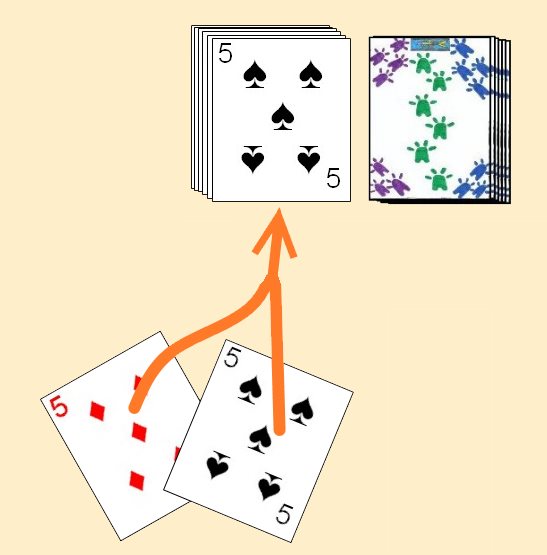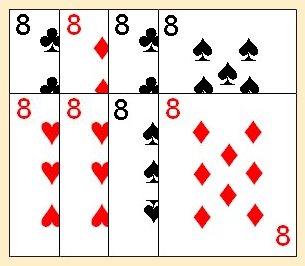Mille is another fun game which plays similar to other games of the 500 Rummy family as well as bears some resemblance to Canasta. This game is thought to have originated in Montreal in the Canadian province of Quebec. Mille is designed for two players using two standard 52 card decks. The ranking of the cards in this deck are as follows (from high to low); Ace, King, Queen, Jack, 10, 9, 8, 7, 6, 5, 4, 3. All twos are considered as wild cards and can be used as replacements for any other card in the deck as used in melds.
Selection of the first dealer can be done in a variety of ways, with the most common method consisting of both players cutting one card from the deck. The higher card drawn becomes the first dealer. If both players draw a card of the same denomination, they must each draw again.
Once the first dealer is selected he should thoroughly shuffle the deck and offer it to his opponent to cut. After the cut, he then deals each player a hand consisting of 15 face-down cards. He then places the remainder of the deck in the center of the table as the stock pile and flips over the top card of this stock pile, laying it next to the stock pile as the discard pile. The dealer's opponent then has the first turn.
 To begin his turn a player must first draw. He may either pick up the
entire discard pile or take the top card of the face down stock pile. A
player may only pick up the pack if he has two (or more) cards of the same
rank as the last card discarded to the discard pile. After taking the card
he must then, during his turn make a meld containing these three cards. A
two which is currently the top of the discard pile can only be picked up by
a player having two other Twos in hand, however, on the first players first
turn only, he may pick up the two to start his turn, if he has no other
twos in hand, adding it to his hand as any other draw from the stock pile.
The player is not obligated to do so, but does have this option in this
case. When doing so, the player must first meld these three cards (the two
cards from his hand and the top card of the stock pile) to the table in
front of himself and then add all the remaining cards from the stock pile into his hand. If the player does not have at least two other cards of this same denomination, he must instead take the top card of the stock pile.
To begin his turn a player must first draw. He may either pick up the
entire discard pile or take the top card of the face down stock pile. A
player may only pick up the pack if he has two (or more) cards of the same
rank as the last card discarded to the discard pile. After taking the card
he must then, during his turn make a meld containing these three cards. A
two which is currently the top of the discard pile can only be picked up by
a player having two other Twos in hand, however, on the first players first
turn only, he may pick up the two to start his turn, if he has no other
twos in hand, adding it to his hand as any other draw from the stock pile.
The player is not obligated to do so, but does have this option in this
case. When doing so, the player must first meld these three cards (the two
cards from his hand and the top card of the stock pile) to the table in
front of himself and then add all the remaining cards from the stock pile into his hand. If the player does not have at least two other cards of this same denomination, he must instead take the top card of the stock pile.
After drawing, the player may then make new melds or add to his own melds already on the table. After making any melds, the player ends his turn by discarding one card from his hand, face-up to the top of the discard pile. The turn then alternates to that player's opponent. A meld in Mille consists of three or more cards of the same rank. As indicated previously, since twos are wild cards a two can be used to replace any other card in such a meld. A meld consisting of all Twos is not considered a wild card meld, and thus cards of other ranks cannot be added to that meld once it has been played to the table.
When a player has just two cards or less remaining in his hand, he must announce this upon reducing his hand to such a number of cards. The game continues until one player runs out of cards either through a meld or making his last discard. When this occurs, the hand immediately ends and the score for the hand is calculated. Each card in the game has a specific point value. Cards a player has legally melded to the table are added to that player's score and any cards still remaining in a players hand (whether they can legally be melded or not) are subtracted from his score. The point values for each individual card in the deck is as follows:
| Card | Point Value |
|---|---|
| 3, 4, 5, 6, 7, 8, 9 | 5 Points Each |
| 10, Jack (Clubs, Hearts, or Spades), Queen (Hearts, Clubs, or Diamonds), King | 10 Points Each |
| Ace | 15 Points Each |
| 2 | 20 Points Each |
| Jack of Diamonds | 50 |
| Queen of Spades | 100 |
In addition, there are certain bonuses a player can earn at the end of a hand. The following are all the bonuses a player could earn points for at the end of the hand:
- Naturals : If a player plays his last card during a hand having played no wild cards during the hand, all his cards score double for this hand. Note that a meld of three or more two's (with no other cards in that same meld) are considered natural, since no two was used as an actual wild card.
- Natural Meld : If a player manages to create a meld consisting of all eight natural cards of the same rank (not containing any wild cards) he has created a Natural Meld. A player who manages to do this scores double points for all cards in that meld. When a player has played a meld consisting of seven cards of the same rank, he must bunch them up to clearly signify that he is close to creating a natural meld. When creating a meld of all 8 natural cards, he flips the meld face-down to distinguish it from a regular meld. A meld of eight two's is also considered a Natural Meld as it contains no twos used as a wild card.

The game continues until, after scores are totaled at the end of a hand, one players score reaches or exceeds 1,200 points with that player then declared the winner. If both players have reached or exceeded this total in the same hand, the player with the higher score is declared the winner. If, after winning the game, the winning player's opponent has scored less than 600 total points, the winning player is said to have won a skunk.